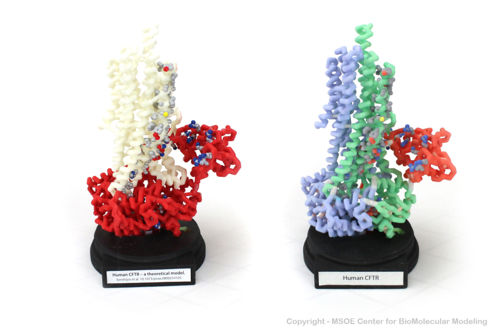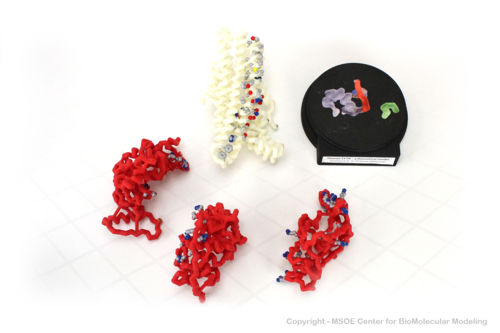Cystic fibrosis transmembrane conductance regulator (CFTR)
From Proteopedia
(Difference between revisions)
| Line 12: | Line 12: | ||
Cystic fibrosis is characterized by decreased chloride transport, which causes mucus to be thicker and stickier. This leads to a variety of problems, including decreased lung capacity, decreased pancreatic enzyme release into the small intestine, increased rates of lung infections, and infertility.<ref>https://ghr.nlm.nih.gov/condition/cystic-fibrosis</ref> There are a wide assortment of mutations that cause cystic fibrosis, with differing symptom severity. The deletion of <scene name='78/785332/F508/1'>F508</scene> causes the protein to not be properly synthesized, and no expression is seen on the cell surface. Other mutations are found in the NBD's; some of these mutations such as S1255P alter the responsiveness to MgATP, while others such as G551S, G1244E, and G1239D decrease the frequency of channel opening. | Cystic fibrosis is characterized by decreased chloride transport, which causes mucus to be thicker and stickier. This leads to a variety of problems, including decreased lung capacity, decreased pancreatic enzyme release into the small intestine, increased rates of lung infections, and infertility.<ref>https://ghr.nlm.nih.gov/condition/cystic-fibrosis</ref> There are a wide assortment of mutations that cause cystic fibrosis, with differing symptom severity. The deletion of <scene name='78/785332/F508/1'>F508</scene> causes the protein to not be properly synthesized, and no expression is seen on the cell surface. Other mutations are found in the NBD's; some of these mutations such as S1255P alter the responsiveness to MgATP, while others such as G551S, G1244E, and G1239D decrease the frequency of channel opening. | ||
| + | |||
| + | Some of the mutations that lead to cystic fibrosis are due to folding errors. There are <scene name='78/785332/Numbered_bundles/2'>12 transmembrane sequences</scene> in CFTR; they are not sequential in their packing. The presence of <scene name='78/785332/Numbered_bundles_pos_res/1'>hydrophilic, positively charged amino acids</scene> in these transmembrane sequences (shown in red) lead to a folding problem: how do you stabilize them until they can be protected by hydrophobic residues and are no longer exposed to the hydrophobic membrane? | ||
==3D Printed Physical Model of the CFTR protein== | ==3D Printed Physical Model of the CFTR protein== | ||
Revision as of 02:30, 8 November 2022
Cystic fibrosis transmembrane conductance regulator (CFTR)
| |||||||||||
References
- ↑ Liu F, Zhang Z, Csanady L, Gadsby DC, Chen J. Molecular Structure of the Human CFTR Ion Channel. Cell. 2017 Mar 23;169(1):85-95.e8. doi: 10.1016/j.cell.2017.02.024. PMID:28340353 doi:http://dx.doi.org/10.1016/j.cell.2017.02.024
- ↑ https://ghr.nlm.nih.gov/condition/cystic-fibrosis



